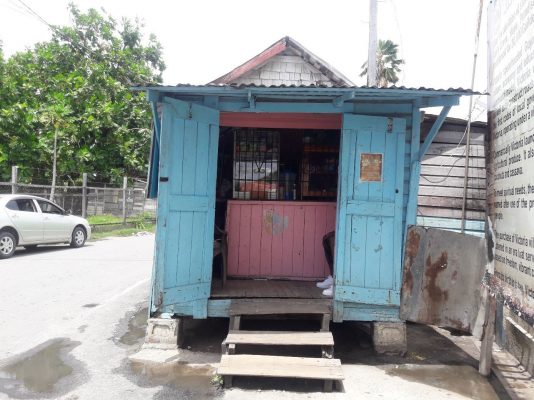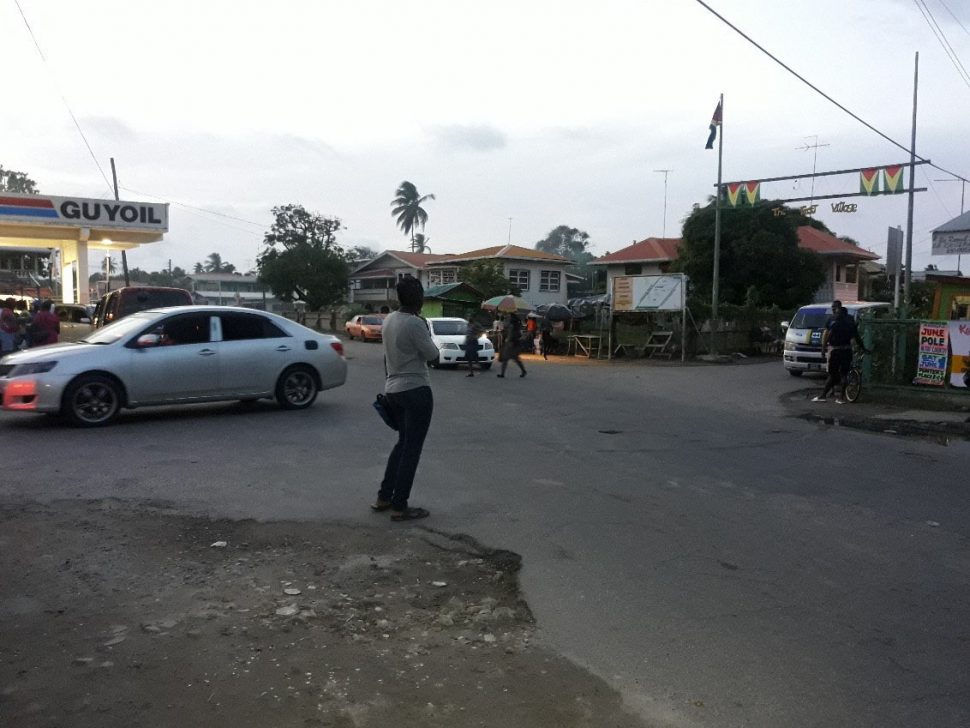At Victoria, the East Coast Highway veers off in two directions, into the villages of Cove and John and Victoria, then continues its journey eastward. The point at which the highway detours is a kind of bottleneck, a space shared by residents of both villages. At that point, the road narrows into congestion and confusion even as the myriad influences from the villages converge. The gatherings there have different missions.
“Four Corner,” as the junction has come to be known, is the place where Victoria leaves its indelible mark. It is a relatively small space into which just about everything that is lively and animated is crammed. There are myriad vendors, shops, drinking establishments and traffic all competing for the same congested space; then there are minibuses and loud music and people wandering aimlessly in the space, all seemingly animated by the rarified air of the ‘four corner’ space. If you are not familiar with ‘Four Corner’ you might even consider it a somewhat intimidating place. The people who congregate there seem relaxed.
In the congestion of the `Four Corner’ area, lies a small wooden structure named Emancipation Hut. It has stood there more than 100 years, a landmark which, in its modesty, speaks to the historical importance of Victoria. Sixty-seven-year-old Hilda Barnwell, (all of Victoria know her as Cousin Hilda), the building’s current Caretaker, also serves as its unofficial archive. Time was when Emancipation Hut served as a bank where the newly freed slaves took the money which they had saved to be counted. It was those monies that that were later to be pooled to purchase Plantation Northbrook. In November 1839 , a year and three months after being freed approximately 83 ex-slaves from five nearby estates: Hope, Dochfour, Ann’s Grove, Paradise and Enmore, pooled six thousand dollars and made a down payment on the purchase price of $10,000.00. Afterwards, it was re-named Victoria, some say after the reigning British monarch at the time; others say that it was to honour the memory of the slaves whose struggle had led to the ‘victory’ of acquiring the plantation.

Much later, during the 1960’s and 1970’s, the Emancipation Hut had become a well-supported Butcher Shop. Cousin Hilda recalled riding past the Butcher’s Shop as a girl and gazing at the huge hunks of meat hanging on display from formidable iron hooks. These days, her tenure as Caretaker has stretched beyond twenty years and it had become transformed into a Snackette, offering home-made snacks like channa, pholourie, pine tarts, cheese rolls as well as her famous fish cakes. You could wash these down with aerated drinks.
Cousin Hilda feared that the contemporary generations in Victoria were altogether lacking in a sense of history so that that they largely lacked an appreciation of the significance of the Hut. She never ceased to remind of what she felt was the important role which it played as a part of the country’s history. It was here, she ‘preached,’ that a movement had begun that had paved the way for the creation of our country, Guyana. The young ones, she felt, seemed not to grasp the significance of what the Hut symbolized.
She is, as well, critical of a Regional Democratic Council which, she says, does not accord the Hut the treatment that it merits. She believes that the Council should be far more involved as the Curator of the building.
These days, there is an uneasiness amongst the vendors who ply their trade in the region of ‘Four Corner,’ their current preoccupation being with the ongoing refurbishment of the East Coast Highway, more specifically the imminent arrival of the disruption to their trading activities on account of what will be their temporary displacement.
There are mixed views on the imminent arrival of the road works at Victoria. There is the Cousin Hilda ‘school of thought’ who sees the restoration of the roads as a broader opportunity to effect a wider beautification exercise at the entrance to the village. During the rainy months, particularly, she says, the entrance to the village becomes an unattractive sight due to the flooding and muddy potholes. “This is the country’s First Village and the entrance is a sore eye,” she quips, asserting that the restoration of the village should be a matter of community pride.
There are, as well, safety considerations. The muddy potholes made accidents more likely. She herself had suffered an injury when her bicycle encountered a pothole and she fell to the ground.
This is not to say that she does not understand the plight of the vendors. Displacement, however temporary, would mean loss of income. These, she says, are ordinary people and numbered amongst them was a single parent for whom vending meant fending for her children.
It is the same with 44 year-old Troy Andrews, a father of four. Troy provides for his family by selling fruits on the side of the road. For the past two years he has provided the villagers with fruit: banana, watermelon, and pineapple, among others, which he offers both as whole fruit and in pre-packaged fruit bowls. More recently Troy has been offering pumpkin, celery and ground provision from his roadside stall.
Troy is brooding. He believes that relocation, however temporary, will injure his ‘hustle. That is not something that he can afford, not with a family to support.
Malika Morris, who occupies a position alongside Troy sells a variety of ‘sweet’ nuts. She, unlike Troy, appears resigned to having to relocate and there is every indication that she is preparing to do just that. The size of her operation makes it easier for her to relocate than some of the others.
Temporary relocation appears to be an issue amongst the taxi drivers too. The area which they had designated, unofficially it seems, a Taxi Rank would be affected by the road works. There is a brisk discourse over whether there should have been official notification and there appears to be division of opinion among the drivers on the issue of relocation.
In the final analysis, however, there appears to be a sort of resignation to the inevitable. Cousin Hilda’s point about the overarching importance of having the road upgraded is probably likely to win the argument and at the end of the day you get a sense that the dislocation will occur without any major fuss. Anthony Frank, the taxi driver, makes a perfectly valid point about the importance of widening the road at the busy `Four Corner’ junction, which, at the height of its congestion can become scary to negotiate. After all, someone else pointed out, as the road repairs had moved steadily eastward other communities had had to endure similar dislocation.
The concerns and anxieties of the people who do business of one sort of another at ‘Four Corner’, though, are real, reflective of conditions in a village whose growth, frankly, has not been commensurate with its standing as our first village. There is evidence of high unemployment and social problems associated with poverty and amongst some people, a sense of straining at the leash to get on with their lives. You sense their fervent hope that the redone highway that is about to pass through Victoria will leave some positive change behind.






